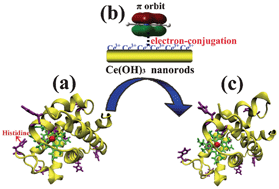Scientists from the University of Chinese Academy of Sciences (Beijing, China) led by Kebin Zhou investigated the interaction between nanorods of Ce(OH)3 and CeO2 and the redox protein hemoglobin.

In this work, Zhou and co-workers hydrothermally prepared Ce(OH)3 and CeO2 nanorods and studied their interaction with a typical redox protein hemoglobin through an electrochemical method combined with Electron Paramagnetic Resonance spectroscopy. Ce(OH)3 was found to be more efficient in enhancing the direct electron-transfer of hemoglobin which may be due to the strong electron-conjugation interaction.
Read the full article for free until the 7th May 2013.
Strong electron-conjugation interaction facilitates electron transfer of hemoglobin by Ce(OH)3nanorods, Lei Wang, Qingfen Luan, Dan Yang, Xin Yao and Kebin Zhou, RSC Adv., 2013, DOI: 10.1039/C3RA40336J










